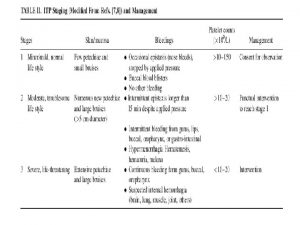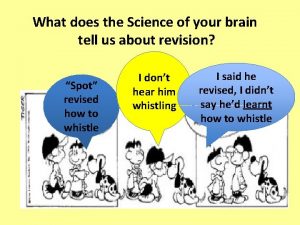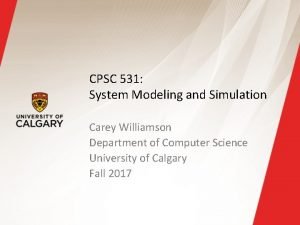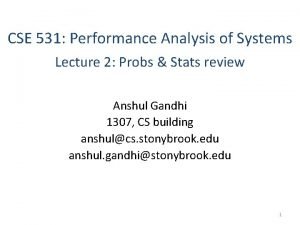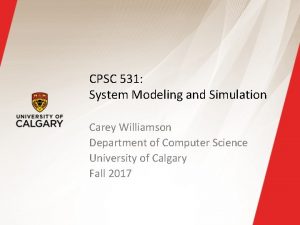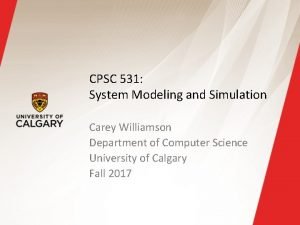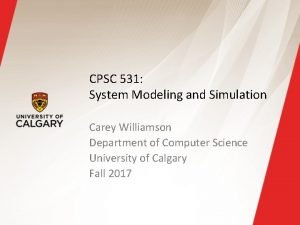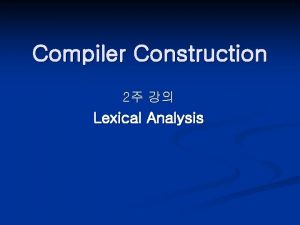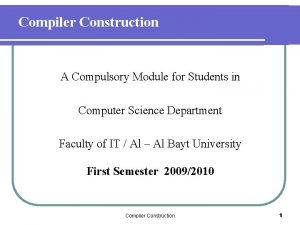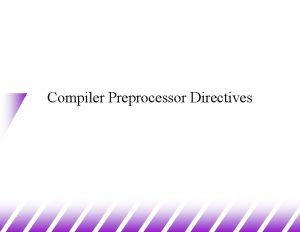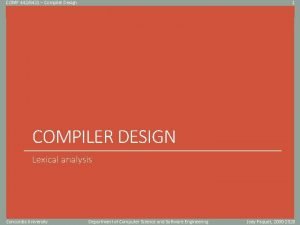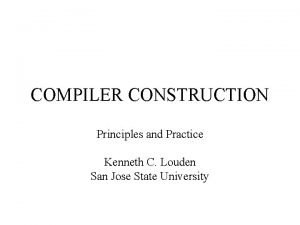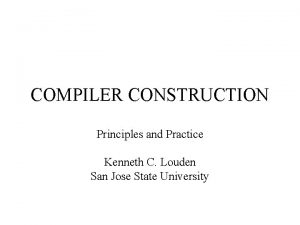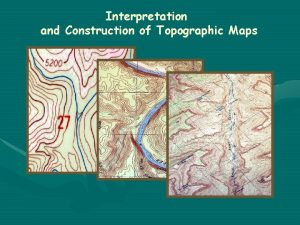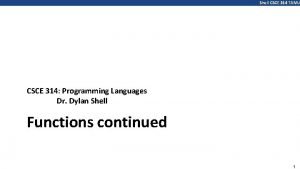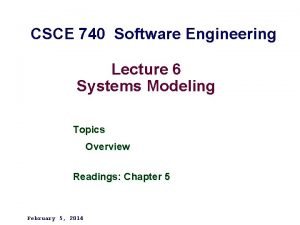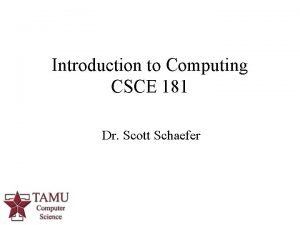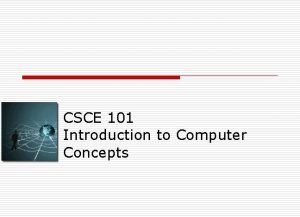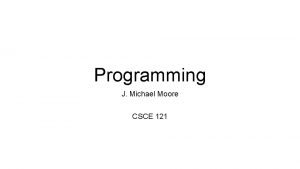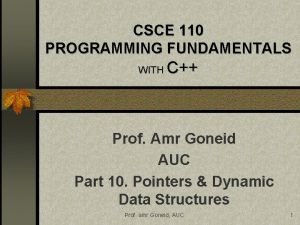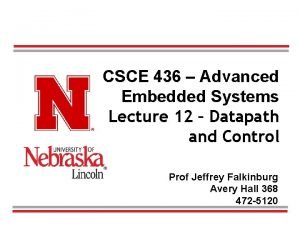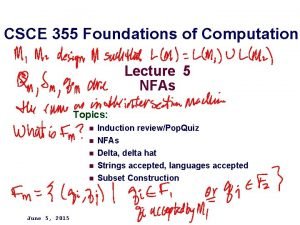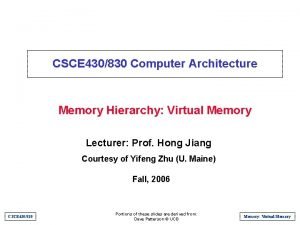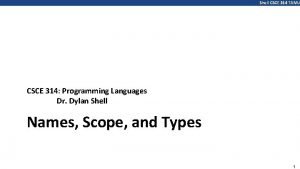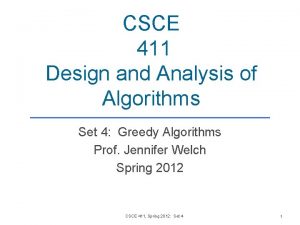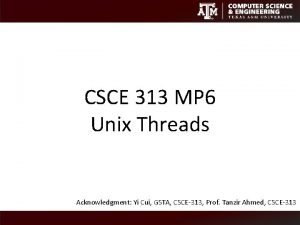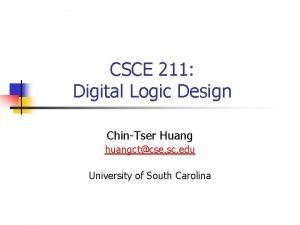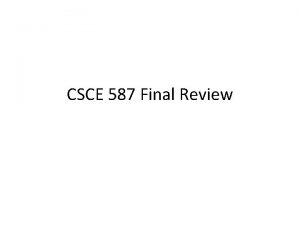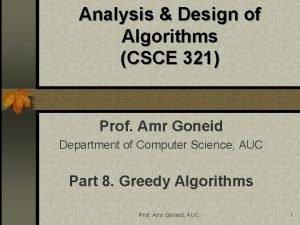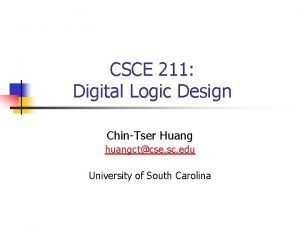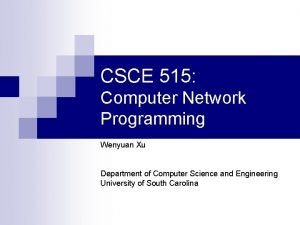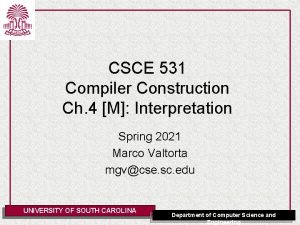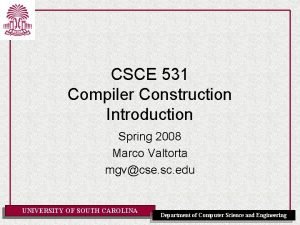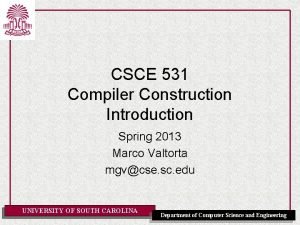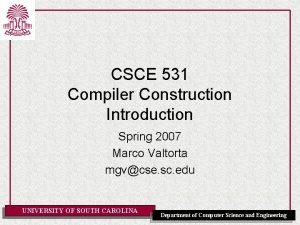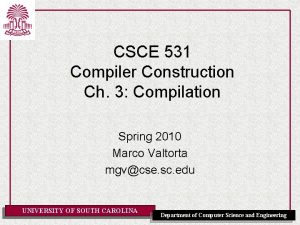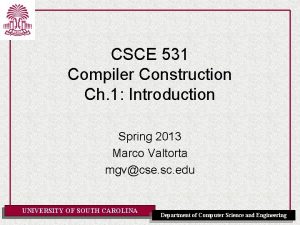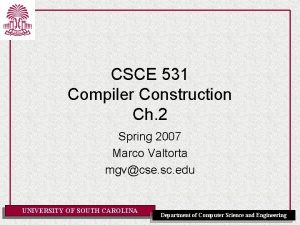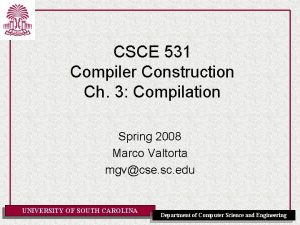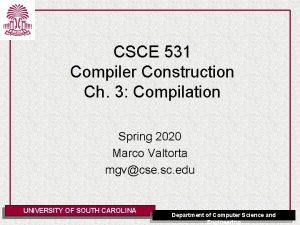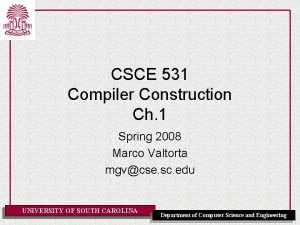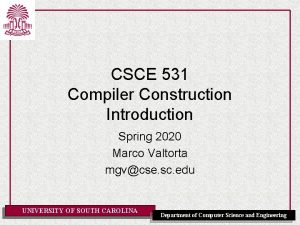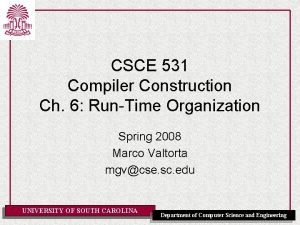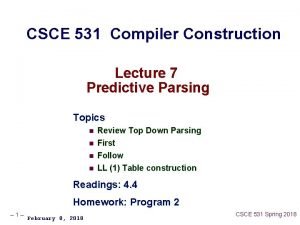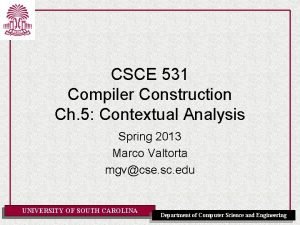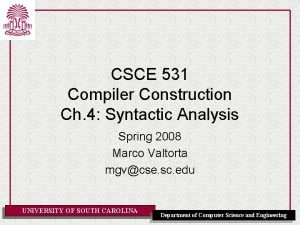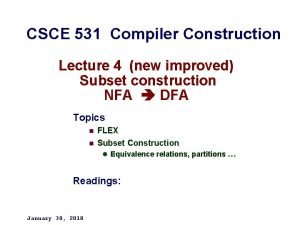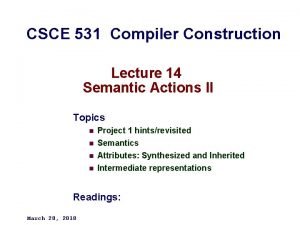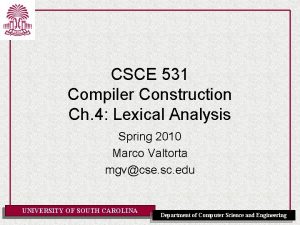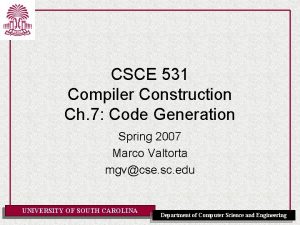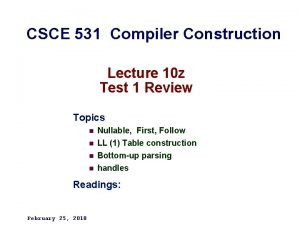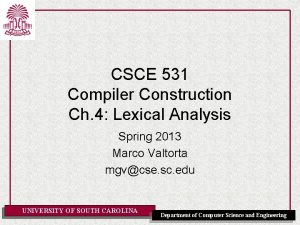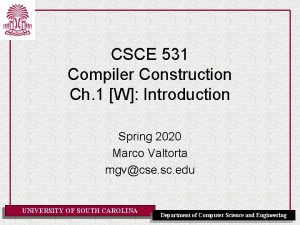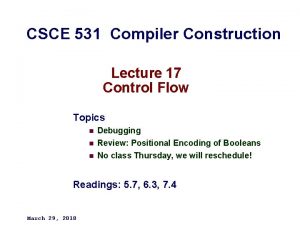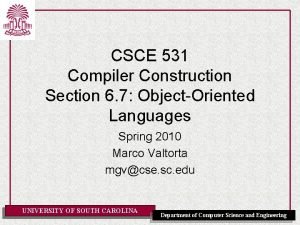CSCE 531 Compiler Construction Ch 8 Interpretation Spring














![Mini-Shell Interpreter Public class Mini. Shell. Command { public String name; public String[] args; Mini-Shell Interpreter Public class Mini. Shell. Command { public String name; public String[] args;](https://slidetodoc.com/presentation_image/f3efd5a6e3eb97df77ebc7307e150993/image-15.jpg)




























- Slides: 43

CSCE 531 Compiler Construction Ch. 8: Interpretation Spring 2010 Marco Valtorta mgv@cse. sc. edu UNIVERSITY OF SOUTH CAROLINA Department of Computer Science and Engineering

Acknowledgment • The slides are based on the textbook and other sources, including slides from Bent Thomsen’s course at the University of Aalborg in Denmark and several other fine textbooks • The three main other compiler textbooks I considered are: – Aho, Alfred V. , Monica S. Lam, Ravi Sethi, and Jeffrey D. Ullman. Compilers: Principles, Techniques, & Tools, 2 nd ed. Addison-Welsey, 2007. (The “dragon book”) – Appel, Andrew W. Modern Compiler Implementation in Java, 2 nd ed. Cambridge, 2002. (Editions in ML and C also available; the “tiger books”) – Grune, Dick, Henri E. Bal, Ceriel J. H. Jacobs, and UNIVERSITY OF SOUTH CAROLINA Department of Computer Science and Engineering Koen G. Langendoen. Modern Compiler Design.

What This Lecture is About A compiler translates a program from a high-level language into an equivalent program in a low-level language. Triangle Program Compile TAM Program Run Result UNIVERSITY OF SOUTH CAROLINA Department of Computer Science and Engineering

Programming Language specification – A Language specification has (at least) three parts: • Syntax of the language: usually formal: EBNF • Contextual constraints: – scope rules (often written in English, but can be formal) – type rules (formal or informal) • Semantics: – defined by the implementation – informal descriptions in English – formal using operational, axiomatic, or denotational semantics UNIVERSITY OF SOUTH CAROLINA Department of Computer Science and Engineering

The “Phases” of a Compiler Source Program Syntax Analysis Error Reports Abstract Syntax Tree Contextual Analysis Error Reports Decorated Abstract Syntax Tree Code Generation Chapter 7 Object Code UNIVERSITY OF SOUTH CAROLINA Department of Computer Science and Engineering

The “Phases” of a Compiler Source Program Syntax Analysis Error Reports Abstract Syntax Tree Contextual Analysis Error Reports Decorated Abstract Syntax Tree Code Generation Object Code UNIVERSITY OF SOUTH CAROLINA Department of Computer Science and Engineering

What’s next? Source program • interpretation • code generation – code selection – register allocation – instruction ordering UNIVERSITY OF SOUTH CAROLINA front-end annotated AST interpreter Code generation Object code Department of Computer Science and Engineering

What’s next? • intermediate code • interpretation • code generation – code selection – register allocation – instruction ordering Source program front-end annotated AST intermediate code generation interpreter UNIVERSITY OF SOUTH CAROLINA Code generation Object code Department of Computer Science and Engineering

Intermediate code • language independent – no structured types, only basic types (char, int, float) – no structured control flow, only (un)conditional jumps • linear format – Java byte code UNIVERSITY OF SOUTH CAROLINA Department of Computer Science and Engineering

The usefulness of Interpreters • Quick implementation of new language – Remember bootstrapping • Testing and debugging • Portability via Abstract Machine • Hardware emulation UNIVERSITY OF SOUTH CAROLINA Department of Computer Science and Engineering

Interpretation • recursive interpretation – operates directly on the AST – simple to write – thorough error checks – very slow: 100 x speed of compiled code • iterative interpretation – operates on intermediate code – good error checking – slow: 10 x UNIVERSITY OF SOUTH CAROLINA Department of Computer Science and Engineering

Iterative interpretation • Follows a very simple scheme: Initialize Do { fetch next instruction analyze instruction execute instruction } while (still running) • Typical source language will have several instructions • Execution then is just a big case statement – one for each instruction UNIVERSITY OF SOUTH CAROLINA Department of Computer Science and Engineering

Iterative Interpreters • Command languages • Query languages – SQL • Simple programming languages – Basic • Virtual Machines UNIVERSITY OF SOUTH CAROLINA Department of Computer Science and Engineering

Mini-shell Script Command Argument Command-Name : : = | | | | Command* Command-Name Argument* end-of-line Filename Literal create delete edit list print quit Filename UNIVERSITY OF SOUTH CAROLINA Department of Computer Science and Engineering
![MiniShell Interpreter Public class Mini Shell Command public String name public String args Mini-Shell Interpreter Public class Mini. Shell. Command { public String name; public String[] args;](https://slidetodoc.com/presentation_image/f3efd5a6e3eb97df77ebc7307e150993/image-15.jpg)
Mini-Shell Interpreter Public class Mini. Shell. Command { public String name; public String[] args; } Public class Mini. Shell. State { //File store… public … //Registers public byte status; //Running or Halted or Failed public static final byte // status values RUNNING = 0, HALTED = 1, FAILED = 2; } UNIVERSITY OF SOUTH CAROLINA Department of Computer Science and Engineering

Mini-Shell Interpreter Public class Mini. Shell extends Mini. Shell. State { public void Interpret () { … // Execute the commands entered by the user // terminating with a quit command } public Mini. Shell. Command read. Analyze () { … //Read, analysze, and return //the next command entered by the user } public void create (String fname) { … // Create empty file wit the given name } public void delete (String[] fnames) { … // Delete all the named files } … public void exec (String fname, String[] args) { … //Run the executable program contained in the … //named files, with the given arguments } UNIVERSITY OF SOUTH CAROLINA } Department of Computer Science and Engineering

Mini-Shell Interpreter Public void interpret () { //Initialize status = RUNNING; do { //Fetch and analyse the next instruction Mini. Shell. Command com = read. Analyze(); // Execute this instruction if (com. name. equals(“create”)) create(com. args[0]); else if (com. name. equals(“delete”)) delete(com. args) else if … else if (com. name. equals(“quit”)) status = HALTED; else status = FAILED; } while (status == RUNNING); } UNIVERSITY OF SOUTH CAROLINA Department of Computer Science and Engineering

Hypo: a Hypothetic Abstract Machine • • • 4096 word code store 4096 word data store PC: program counter, starts at 0 ACC: general purpose register 4 -bit op-code • 12 -bit operand • Instruction set: UNIVERSITY OF SOUTH CAROLINA Department of Computer Science and Engineering

Hypo Interpreter Implementation (1) UNIVERSITY OF SOUTH CAROLINA Department of Computer Science and Engineering

Hypo Interpreter Implementation (2) UNIVERSITY OF SOUTH CAROLINA Department of Computer Science and Engineering

TAM • The Triangle Abstract Machine (TAM) is implemented as an iterative interpreter The file Interpreter. java. . Triangletools-2. 1TAMInterpreter. java Implements an interpreter for the Triangle Assembly Language (TAL), viz. the Triangle Abstract Machine (TAM). UNIVERSITY OF SOUTH CAROLINA Department of Computer Science and Engineering

TAM machine architecture • TAM is a stack machine – There are no data registers as in register machines. – The temporary data are stored in the stack. • But, there are special registers (Table C. 1 of page 407) • TAM Instruction Set – Instruction Format (Figure C. 5 of page 408) – op: opcode (4 bits) • r: special register number (4 bits) • n: size of the operand (8 bits) • d: displacement (16 bits) • Instruction Set – Table C. 2 of page 409 UNIVERSITY OF SOUTH CAROLINA Department of Computer Science and Engineering

TAM Registers UNIVERSITY OF SOUTH CAROLINA Department of Computer Science and Engineering

TAM Machine code • Machine code consists of 32 -bit instructions in the code store – op (4 bits), type of instruction – r (4 bits), register – n (8 bits), size – d (16 bits), displacement • Example: LOAD (1) 3[LB]: – op = 0 (0000) – r = 8 (1000) – n = 1 (00000001) – d = 3 (000000011) • 0000 1000 0001 0000 0011 UNIVERSITY OF SOUTH CAROLINA Department of Computer Science and Engineering

TAM Instruction set UNIVERSITY OF SOUTH CAROLINA Department of Computer Science and Engineering

TAM machine architecture • Two Storage Areas – Code Store (32 bits words) • Code Segment: to store the code of the program to run – Pointed to by CB and CT • Primitive Segment: to store the code for primitive operations – Pointed to by PB and PT – Data Store (16 bits words) • Stack – global segment at the base of the stack » Pointed to by SB – stack area for stack frames of procedure and function calls » Pointed to by LB and ST • Heap – heap area for the dynamic allocation of variables » Pointed to by HB and HT UNIVERSITY OF SOUTH CAROLINA Department of Computer Science and Engineering

TAM machine architecture UNIVERSITY OF SOUTH CAROLINA Department of Computer Science and Engineering

Global Variable and Assignment Command • Triangle source code • TAM assembler code ! simple expression and assignment 0: PUSH 1 let 1: LOADL 5 var n: Integer 2: STORE (1) 0[SB] in 3: LOAD (1) 0[SB] begin 4: LOADL 1 n : = 5; 5: CALL add n : = n + 1 6: STORE (1) 0[SB] end 7: POP (0) 1 8: HALT UNIVERSITY OF SOUTH CAROLINA Department of Computer Science and Engineering

Recursive interpretation • Two phased strategy – Fetch and analyze program • Recursively analyzing the phrase structure of source • Generating AST • Performing contextual analysis – Recursively via visitor – Execute program • Recursively by walking the decorated AST UNIVERSITY OF SOUTH CAROLINA Department of Computer Science and Engineering

Recursive Interpreter for Mini. Triangle Representing Mini. Triangle values in Java: public abstract class Value { } public class Int. Value extends Value { public short i; } public class Bool. Value extends Value { public boolean b; } public class Undefined. Value extends Value { } UNIVERSITY OF SOUTH CAROLINA Department of Computer Science and Engineering

Recursive Interpreter for Mini. Triangle A Java class to represent the state of the interpreter: public class Mini. Triangle. State { public static final short DATASIZE = …; //Code Store Program program; //decorated AST //Data store Value[] data = new Value[DATASIZE]; //Register … byte status; public static final byte //status value RUNNING = 0, HALTED = 1, FAILED = 2; } The class AST and its subclasses Program, Command, Expression, Declaration, as described in Example 4. 19 are assumed. UNIVERSITY OF SOUTH CAROLINA Department of Computer Science and Engineering

AST Construction: Review (Sec. 4. 4. 2) Here is how Watt and Brown’s recursive descent parser actually constructs an AST. N : : = X private N parse. N() { N its. AST; parse X at the same time constructing its. AST return its. AST; } UNIVERSITY OF SOUTH CAROLINA Department of Computer Science and Engineering

Recursive Interpreter for Mini. Triangle public class Mini. Triangle. Processor extends Mini. Triangle. State implements Visitor { public void fetch. Analyze () { //load the program into the code store after //performing syntactic and contextual analysis //requires -a parser (Example 4. 12), // -a contextual analyzer (Example 5. 11), // -a static storage allocator (Example 7. 13) } public void run () { … // run the program public Object visit…Command (…Command com, Object arg) { //execute com, returning null (ignoring arg) } public Object visit…Expression (…Expression expr, Object arg) { //Evaluate expr, returning its result } public Object visit… } UNIVERSITY OF SOUTH CAROLINA Department of Computer Science and Engineering

Recursive Interpreter for public Object visit. Assign. Command Mini. Triangle (Assign. Command com, Object arg) { Value val = (Value) com. E. visit(this, null); assign(com. V, val); return null; } public Objects visit. Call. Command (Call. Command com, Object arg) { Value val = (Value) com. E. visit(this, null); Call. Standard. Proc(com. I, val); return null; } public Object visit. Sequential. Command (Sequential. Command com, Object arg) { com. C 1. visit(this, null); com. C 2. visit(this, null); return null; } UNIVERSITY OF SOUTH CAROLINA Department of Computer Science and Engineering

Recursive Interpreter for Mini. Triangle public Object visit. If. Command (If. Command com, Object arg) { Bool. Value val = (Bool. Value) com. E. visit(this, null); if (val. b) com. C 1. visit(this, null); else com. C 2. visit(this, null); return null; } public Object visit. While. Command (While. Command com, Object arg) { for (; ; ) { Bool. Value val = (Bool. Value) com. E. visit(this, null) if (! Val. b) break; com. C. visit(this, null); } return null; } UNIVERSITY OF SOUTH CAROLINA Department of Computer Science and Engineering

Recursive Interpreter for Mini. Triangle public Object visit. Integer. Expression (Integer. Expression expr, Object arg){ return new Int. Value(Valuation(expr. IL)); } public Object visit. Vname. Expression (Vname. Expression expr, Object arg) { return fetch(expr. V); } … public Object visit. Binary. Expression (Binary. Expression expr, Object arg){ Value val 1 = (Value) expr. E 1. visit(this, null); Value val 2 = (Value) expr. E 2. visit(this, null); return apply. Binary(expr. O, val 1, val 2); } UNIVERSITY OF SOUTH CAROLINA Department of Computer Science and Engineering

Recursive Interpreter for Mini. Triangle public Object visit. Const. Declaration (Const. Declaration decl, Object arg){ Known. Address entity = (Known. Address) decl. entity; Value val = (Value) decl. E. visit(this, null); data[entity. address] = val; return null; } public Object visit. Var. Declaration (Var. Declaration decl, Object arg){ Known. Address entity = (Known. Address) decl. entity; data[entity. address] = new Undefined. Value(); return null; } public Object visit. Sequential. Declaration (Sequential. Declaration decl, Object arg){ decl. D 1. visit(this, null); decl. D 2. visit(this, null); return null; } UNIVERSITY OF SOUTH CAROLINA Department of Computer Science and Engineering

Recursive Interpreter for Mini. Triangle Public Value fetch (Vname vname) { Known. Address entity = (Known. Address) vname. visit(this, null); return data[entity. address]; } Public void assign (Vname vname, Value val) { Known. Address entity = (Known. Address) vname. visit(this, null); data[entity. address] = val; } Public void fetch. Analyze () { Parser parse = new Parse(…); Checker checker = new Checker(…); Storage. Allocator allocator = new Storage. Allocator(); program = parser. parse(); checker. check(program); allocator. allocate. Addresses(program); } Public void run () { program. C. visit(this, null); } UNIVERSITY OF SOUTH CAROLINA Department of Computer Science and Engineering

Alternative Design for the Mini. Triangle Recursive Interpreter • Design similar to the one for mini-Basic (Example 8. 3): – Equip each Command subclass with an execute method – Equip each Expression subclass with an evaluate method – Equip each Declaration subclass with an elaborate method • Each of these interpreting states would be passed the abstract machine state as argument. UNIVERSITY OF SOUTH CAROLINA Department of Computer Science and Engineering

Recursive Interpreter and Semantics • Code for Recursive Interpreter is very close to denotational semantics UNIVERSITY OF SOUTH CAROLINA Department of Computer Science and Engineering

Recursive interpreters • Usage – Quick implementation of high-level language • LISP, SML, Prolog, … , all started out as interpreted languages – Scripting languages • If the language is more complex than a simple command structure we need to do all the frontend and static semantics work anyway. • Web languages – Java. Script, Ph. P, ASP where scripts are mixed with HTML or XML tags UNIVERSITY OF SOUTH CAROLINA Department of Computer Science and Engineering

Interpreters are everywhere on the web Web-Client HTML-Form (+Java. Script) Reply Web-Server Call PHP interpreter Submit Data Web-Browser Database Server WWW Response UNIVERSITY OF SOUTH CAROLINA PHP Script Response LAN DBMS SQL commands Database Output Department of Computer Science and Engineering

Interpreters versus Compilers Q: What are the tradeoffs between compilation and interpretation? Compilers typically offer more advantages when – programs are deployed in a production setting – programs are “repetitive” – the instructions of the programming language are complex Interpreters typically are a better choice when – we are in a development/testing/debugging stage – programs are run once and then discarded – the instructions of the language are simple – the execution speed is overshadowed by other factors • e. g. on a web server where communications costs are much higher than execution speed UNIVERSITY OF SOUTH CAROLINA Department of Computer Science and Engineering
 Lex yacc example
Lex yacc example Cross compiler in compiler design
Cross compiler in compiler design Itp 100
Itp 100 531 area code
531 area code Cpsc 531
Cpsc 531 Cse 531
Cse 531 Network slicing onap
Network slicing onap Cpsc 531
Cpsc 531 Cpsc 531
Cpsc 531 531 warm up
531 warm up Cpsc 531
Cpsc 531 Attributes of tokens in compiler design
Attributes of tokens in compiler design Phases of compiler construction
Phases of compiler construction Preprocessor in compiler construction
Preprocessor in compiler construction Thompson construction in compiler design
Thompson construction in compiler design Interpreter in compiler construction
Interpreter in compiler construction Front end and back end in compiler design
Front end and back end in compiler design Kenneth c. louden
Kenneth c. louden Compiler construction: principles and practice
Compiler construction: principles and practice Static and dynamic type checking in compiler design
Static and dynamic type checking in compiler design Compiler front end
Compiler front end How does interpretation b differ from interpretation a
How does interpretation b differ from interpretation a February is winter or spring
February is winter or spring Kim ki duk summer fall winter spring
Kim ki duk summer fall winter spring Interpretation and construction
Interpretation and construction Interpreting topographic maps
Interpreting topographic maps Strict interpretation of taxing statutes
Strict interpretation of taxing statutes Dylan shell tamu
Dylan shell tamu Csce dropbox
Csce dropbox Csce 181
Csce 181 Csce 101
Csce 101 Csce 121 tamu
Csce 121 tamu Csce 110 tamu syllabus
Csce 110 tamu syllabus Csce 436
Csce 436 Csce 355
Csce 355 Virtual memory
Virtual memory Csce 314 tamu
Csce 314 tamu Csce 411
Csce 411 Csce 313 tanzir
Csce 313 tanzir Csce 211
Csce 211 Csce 587
Csce 587 Csce 411
Csce 411 Csce 211
Csce 211 Csce 481
Csce 481


